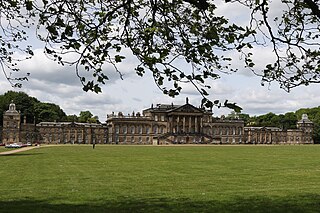
Wentworth Woodhouse is a Grade I listed country house in the village of Wentworth, in the Metropolitan Borough of Rotherham in South Yorkshire, England. It is currently owned by the Wentworth Woodhouse Preservation Trust. The building has more than 300 rooms, although the precise number is unclear, with 250,000 square feet (23,000 m2) of floorspace. It covers an area of more than 2.5 acres (1.0 ha), and is surrounded by a 180-acre (73 ha) park, and an estate of 15,000 acres (6,100 ha).

Bretton Hall is a country house in West Bretton near Wakefield, West Yorkshire, England. It housed Bretton Hall College from 1949 until 2001 and was a campus of the University of Leeds (2001–2007). It is a Grade II* listed building.

Burton Constable Hall is a large Elizabethan country house in England, with 18th- and 19th-century interiors and a fine 18th-century cabinet of curiosities. The hall, a Grade I listed building, is set in a park designed by Capability Brown with an area of 300 acres (1.2 km2). It is located 3 miles (5 km) south-east of the village of Skirlaugh in the East Riding of Yorkshire, approximately 9 miles (14 km) north-east of the city of Hull, and has been the home of the Constable family for over 400 years.
Sir (William) Marcus John Worsley, 5th Baronet,, was a British Conservative Party politician. He served as a Member of Parliament in four parliaments between 1959 and 1974, and served as High Sheriff and Lord Lieutenant for North Yorkshire.

Upsall Castle is a fourteenth-century ruin, park and manor house in Upsall, in the Hambleton district of North Yorkshire, England.

Burton Agnes Hall is an Elizabethan manor house in the village of Burton Agnes, near Driffield in the East Riding of Yorkshire, England. It was built by Sir Henry Griffith in 1601–10 to designs attributed to Robert Smythson. The older Norman Burton Agnes Manor House, originally built in 1173, still stands on an adjacent site; both buildings are now Grade I listed buildings.

South Dalton is a village in the East Riding of Yorkshire, England. It is situated 1 mile (1.6 km) to the west of the B1248 road, and approximately 6 miles (10 km) north-east from the market town of Market Weighton and 5 miles (8 km) north-west from the market town of Beverley. Etton lies 1.5 miles (2.4 km) to the south-east. North Dalton is approximately 4.5 miles (7 km) north-west, with the villages of Middleton on the Wolds and Lund between.

Hovingham is a large village and civil parish in the Ryedale district of North Yorkshire, England. It is on the edge of the Howardian Hills and about 7 miles (11 km) south of Kirkbymoorside.

Bramham Park is a Grade I listed 18th-century country house in Bramham, between Leeds and Wetherby, in West Yorkshire, England.
Col. Sir William Arthington Worsley, 4th Baronet, was an English landowner and amateur first-class cricketer.

Bessingby is a village in the East Riding of Yorkshire, England. It lies immediately south-east from the A614, approximately 1.5 miles (2.4 km) south-west from Bridlington. The village forms part of Bridlington civil parish.

Ganton is a village and civil parish in the Ryedale district of North Yorkshire, England. It is situated on the south side of the Vale of Pickering immediately north of the Yorkshire Wolds. Ganton lies 7 miles (11 km) west of the coastal town of Filey, and 9 miles (14 km) south-west of Scarborough. It was historically part of the East Riding of Yorkshire until 1974.

The Worsley family is an English family that is derived from Sir Elias de Workesley, a Norman knight who was a youth at the time of the Norman conquest. He later accompanied Duke Robert II of Normandy on the First Crusade and was buried at Rhodes.
The High Sheriff of North Yorkshire is a current High Sheriff title which has existed since 1974. For around 1,000 years the entire area of Yorkshire was covered by a single High Sheriff of Yorkshire. After the Local Government Act 1972 the title was split to cover several newly created counties, including North Yorkshire.

Ripley Castle is a Grade I listed 14th-century country house in Ripley, North Yorkshire, England, 3 miles (4.8 km) north of Harrogate.
Giles Arthington Worsley was an English architectural historian, author, editor, journalist and critic, specialising in British country houses. He was the second son of Sir Marcus Worsley, 5th Baronet, of Hovingham Hall, a nephew of Katharine, Duchess of Kent, and died of cancer aged 44.

Rode Hall, a Georgian country house, is the seat of the Wilbraham family, members of the landed gentry in the parish of Odd Rode, Cheshire, England. The estate, with the original timber-framed manor house, was purchased by the Wilbrahams from the ancient Rode family in 1669. The medieval manor house was replaced between 1700 and 1708 by a brick-built seven-bay building; a second building, with five bays, was built in 1752; the two buildings being joined in 1800 to form the present Rode Hall.

Thomas Worsley was an English academic and priest. He was the third Master of Downing College, Cambridge from 1836 until 1885.

Boynton Hall is a country house in the village of Boynton near Bridlington, East Riding of Yorkshire, England. It is a Grade I listed building.

Sir William Ralph Worsley, 6th Baronet,, is a British forester, farmer and businessman.
















